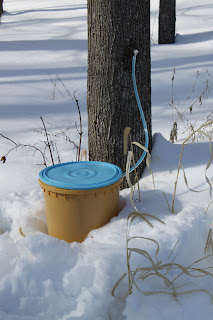When days are warm but
nights still freeze
The sap starts flowing
in the trees…
For the past few weeks, when 10:14pm rolls around, you’ll
find us on the couch, eyeballs glued to the TV, fingers crossed, waiting for just the right weather report. The maple sap run starts when the daytime
highs climb a few degrees above freezing for a few days in a row– the sap rises
from the roots toward the warm, sunny branches.
But when the air temperature drops back below freezing at night, it
flows back down to hide out in the warmth of the ground. Up and down, up and down. Except for that bit that flows by our taps and
into our buckets.
Since we haven’t seen that sought-after five-day forecast yet,
we’ve just been easing into the season so far. First, we cleared out the Sugar Shack and
brought the equipment out of hibernation.
Buckets, taps, storage drums, and the big kahuna: the boiling pan. Everything
needed to be completely sanitized, to ensure that all the sugar-eating bacteria
were eliminated. The taps were small
enough that we could boil them to get them squeaky clean. Everything else got a good scrubbing with
bleach and elbow grease. The wood
boiling stove just needed a good once-over to get rid of the spiders and other
creepy crawlies that made their winter home there. Then we stacked a full cord of dried, split
wood neatly beside the Sugar Shack. We
tapped the tree closest to the house as a tester tree. And then, we waited. And watched the weather report. And waited some more.

Saturday, we just couldn’t stand the waiting any more. With daytime temperatures projected to be
right about freezing this week, we decided to tap the first 25 trees. We chose a stand of trees on the southeast
slope where it’s a little sunnier, and maybe a little warmer. And now we wait again, for the first flow of
the sweet sap of 2013…



 Happy Easter from the hens (and humans) of Kopp's Crops!
Happy Easter from the hens (and humans) of Kopp's Crops!




